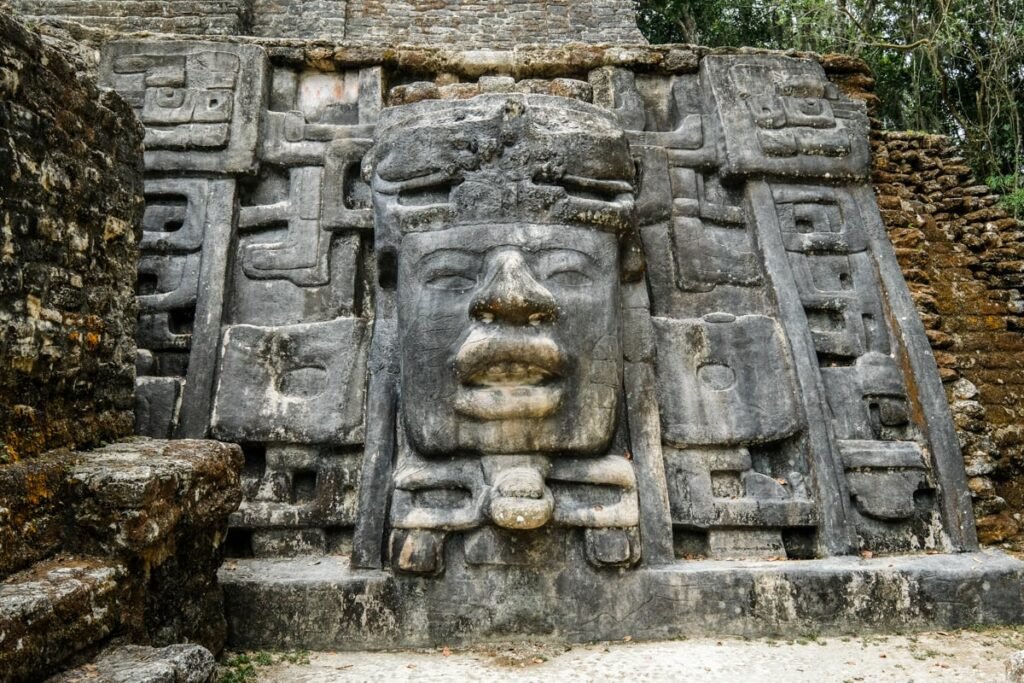Hidden deep in the jungles of northern Belize, Lamanai is one of the country’s most unique and atmospheric Mayan ruins. The name Lamanai means “submerged crocodile” in the Maya language — a nod to the reptiles that still inhabit the nearby New River.
What makes Lamanai especially intriguing is its remote location, jungle setting, and impressive architecture, including the iconic Mask Temple, which features giant carved stone faces that are among the best-preserved in all of the Mayan world.
This site was continuously inhabited for over 3,000 years, from around 1500 BC to the 17th century, making it one of the longest-occupied Mayan cities ever discovered.
🗿 Highlights of Lamanai Ruins
• Mask Temple
The star attraction, the Mask Temple (Structure N9-56), features two 13-foot-high stone masks representing ancient Maya deities or rulers. These were later covered and preserved by newer temple layers, which is why they’re still in such excellent condition today.
• High Temple
Climb to the top of this 33-meter (108-foot) structure for panoramic views over the rainforest and the New River Lagoon. It’s a steep climb, but worth it.
• Jaguar Temple
This smaller temple is named for the jaguar mask on its lower facade. It reflects the deep spiritual importance of big cats in Maya mythology.
• Ball Court
Though smaller than others in Mesoamerica, the Lamanai ball court was used for sacred ceremonial games, sometimes with serious consequences for the losing team.
🐒 What To Expect
- Lamanai is one of the few Maya ruins in Belize that still feels wild and off-the-beaten-path.
- Wildlife sightings are common — expect to hear or see howler monkeys, toucans, and maybe even crocodiles near the water.
- The trails are surrounded by dense jungle, which adds to the Indiana Jones vibe.
🚤 How To Get There
The most popular and scenic way to reach Lamanai is via boat tour from Orange Walk Town, which cruises along the New River for about 1 hour before arriving at the ruins. Along the way, you’ll spot birds, bats, and crocodiles.
Lamanai Ruins in Belize: The Mayan Mask Temple Adventure
The Lamanai ruins in Belize are some of the most fascinating Mayan sites in Central America, featuring a famous Mask Temple with giant stone faces carved right into the temple’s foundation — it honestly feels like something straight out of Indiana Jones!
The name Lamanai means “submerged crocodile,” and this riverside location was continuously inhabited by the Maya for thousands of years. Excavation only began in the 1970s and is still ongoing today. Some of the temples are open for climbing, offering panoramic views of the surrounding jungle from the top!
You can visit Lamanai easily on a day trip from Orange Walk, Belize City, or even San Pedro on Ambergris Caye. One of the best parts of the experience is the scenic riverboat ride through dense jungle — a chance to hear tropical birds and howler monkeys echoing through the treetops.
This travel guide will explain how to get to Lamanai, what to see at the ruins, which tour packages are best, and everything else you need to know before you go!
📍 Where Is Lamanai Located & How To Get There
The Lamanai ruins are located in northern Belize, nestled along the New River Lagoon. While the ruins are in a remote jungle setting, getting there is part of the adventure!
The closest major town is Orange Walk, but Lamanai is also accessible on a day trip from many places in northern Belize — including Belize City, Ladyville, Los Lagos, Caye Caulker, or San Pedro on Ambergris Caye.
🚗 Getting There By Car
If you’re planning to drive, it’s about 1 hour from Orange Walk or over 2 hours from Belize City. The distance isn’t long, but the roads near Lamanai are unpaved and bumpy, especially in the final stretch. A 4WD vehicle is highly recommended, especially during the rainy season, when the roads can get muddy and tricky to navigate.
🚤 Getting There By Boat (Recommended!)
The most popular and enjoyable way to reach Lamanai is by riverboat. Most tours take you on a scenic boat ride from Orange Walk down the New River, passing through mangroves, lagoons, and thick jungle.
This journey takes about 1 hour, and it’s one of the highlights of the trip. Along the way, keep an eye out for exotic birds, crocodiles, bats, and even howler monkeys in the trees. It’s a fantastic way to immerse yourself in Belize’s wildlife before even reaching the ruins.
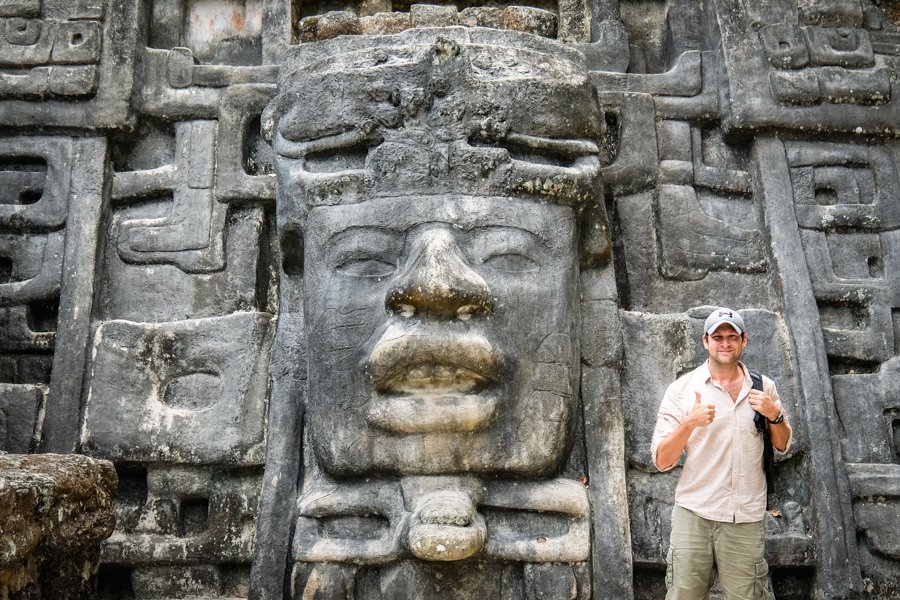
🏛️ What To Expect At Lamanai Ruins
The Lamanai Archaeological Reserve is home to five major Mayan temples, spread out across shaded jungle trails. It’s one of the most atmospheric and wildlife-rich ruins in Central America, with ancient structures, tropical birds, and howler monkeys adding to the experience.
In addition to the ruins, the site includes a small museum with Mayan artifacts and stelae, and a 19th-century sugar mill, now dramatically swallowed by a massive strangler fig tree after being abandoned.
🗺️ Lamanai Temple Highlights
Most tours follow a loop through the ruins in this general order:
- Jaguar Temple – Known for its jaguar-like stone decorations.
- Royal Complex – A cluster of structures thought to be elite residences or ceremonial areas.
- Ball Court – Where the Maya played their sacred ballgame.
- High Temple – The tallest structure at Lamanai; you can climb to the top for sweeping jungle views.
- Mask Temple – Famous for its towering carved faces, and a definite trip highlight!
You’ll walk about 1.5 kilometers (1 mile) in total, but it’s all nicely spaced out over 1.5 to 2 hours. The trails are mostly flat and shaded, making this a relatively easy and accessible walk, although climbing the temples can be more strenuous due to steep steps and heat.
🐒 Wildlife At Lamanai
One of the coolest things about visiting Lamanai is how alive it feels. The ruins are surrounded by jungle, so it’s common to spot:
- Howler monkeys (you’ll hear their roar before you see them!)
- Spider monkeys
- Crocodiles near the river
- Toucans, iguanas, tarantulas, and other rainforest creatures
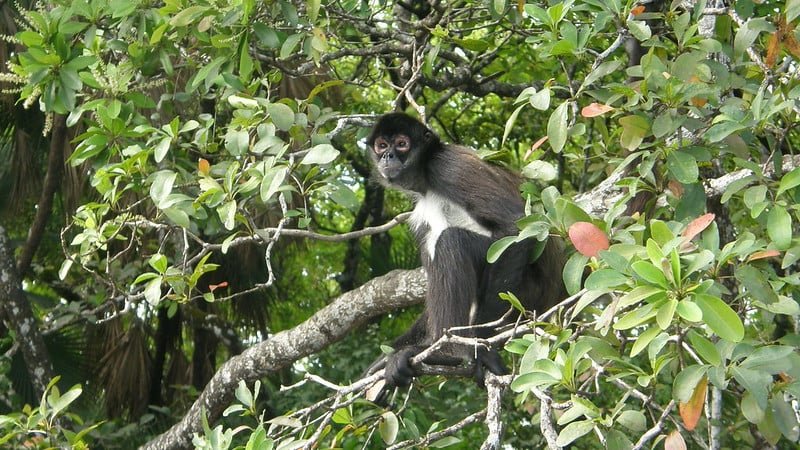
🐆 Jaguar Temple
The Jaguar Temple is usually the first major structure you’ll encounter on a tour of the Lamanai ruins — and it makes a strong first impression.
This pyramid-shaped temple rises almost 30 meters (100 feet) high and has seven distinct tiers. Interestingly, the base of the structure is still partially buried, and if it were fully excavated, it would actually be the tallest building at Lamanai!
The temple gets its name from the two blocky stone masks flanking its front, which are believed to represent jaguars — sacred animals in Mayan culture. Although, to be honest, I thought they looked a bit more like crocodile heads, which would also make sense given the site’s name (“Lamanai” means submerged crocodile in the Mayan language).
Some tours include climbing the Jaguar Temple, while others admire it from the ground — this can depend on current preservation rules or your guide’s plan. Either way, it’s a striking structure that sets the tone for the rest of your visit.
Inside, archaeologists have uncovered hidden ceremonial caches, including jade masks and other precious Mayan relics. These discoveries give a glimpse into the rich cultural and spiritual life that once thrived here.
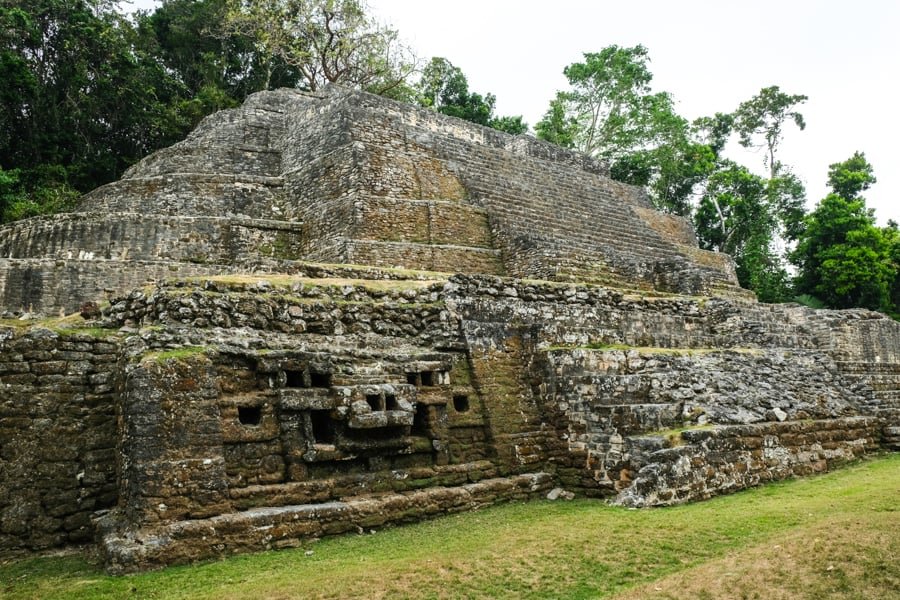

🏯 High Temple
The High Temple is the tallest monument at Lamanai, and when it was originally built, it may have been the tallest building in the entire Mayan world — a true architectural marvel for its time.
Standing at 33 meters (108 feet) tall — about the height of a modern 10-story building — it’s still one of the largest known Mayan structures in Central America today.
If you’re lucky, you’ll have the chance to climb to the top, where you’re rewarded with breathtaking panoramic views over the Belizean jungle canopy. Unfortunately, the temple was closed for restoration during my visit, but even from the base, it’s an awe-inspiring sight.
The climb to the top is steep and physically demanding, with uneven and narrow stone steps, so be sure to take it slow and use caution on the way up and down. But if it’s open and you’re up for the challenge, the view is absolutely worth it!
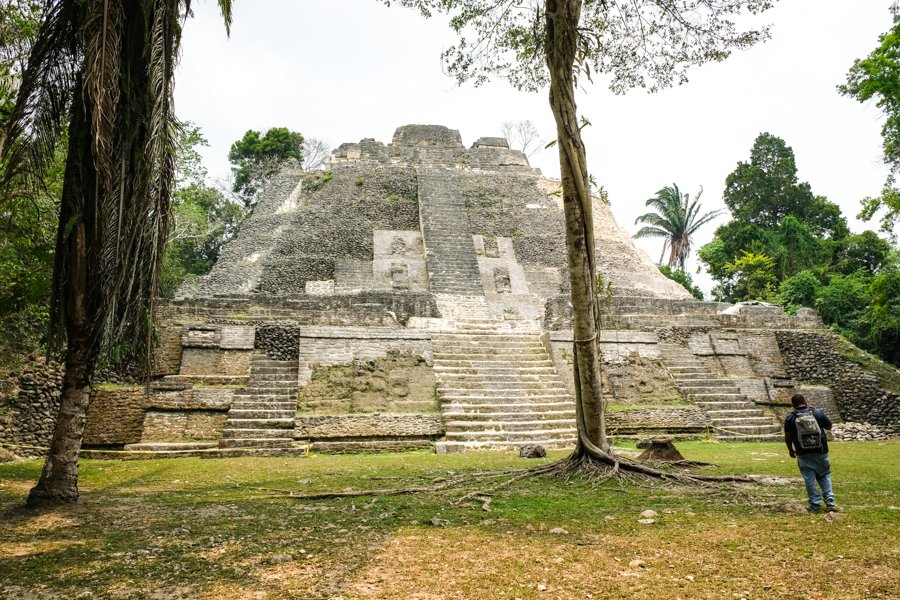
🗿 Mask Temple
Last but definitely not least, the Mask Temple was easily my favorite part of Lamanai — even though it’s one of the smaller temples on site, it’s packed with character and history.
Like a few of the others, this temple is climbable, and you can enjoy nice jungle views from the top. But the real showstopper here is what’s at the base: two massive stone masks carved into the foundation — giving the temple its name.
Each mask stands at nearly 4 meters tall (13 feet) and is believed to depict an ancient Maya king wearing a crocodile headdress, which ties perfectly into Lamanai’s name: “Submerged Crocodile.” It’s an iconic and unforgettable sight that feels like something out of Indiana Jones.
There’s one mask on each side of the temple’s front face, and they’re impressively preserved considering their age. If you’re a fan of ancient symbolism or just love epic stone carvings, this is the spot that will stay with you long after your visit.
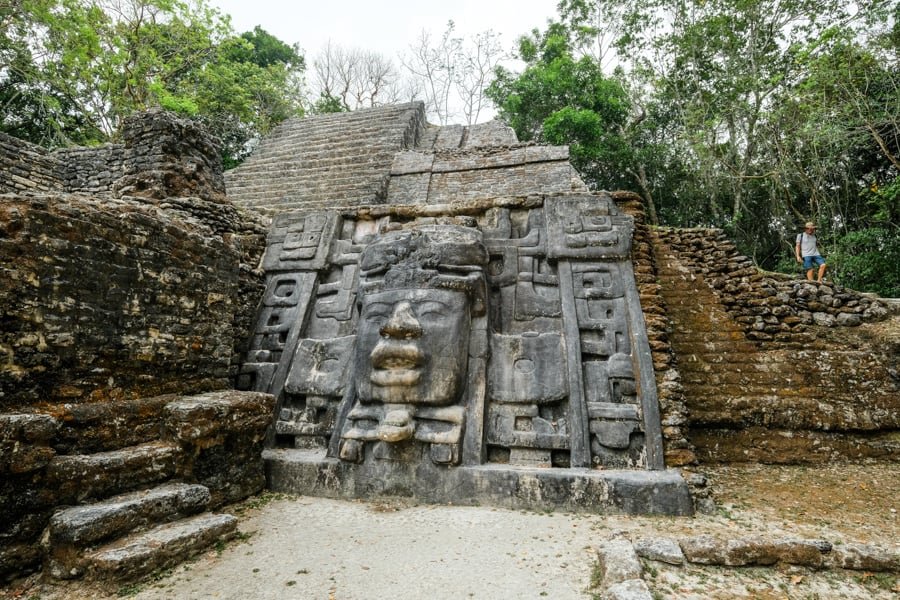
🧱 A Closer Look at the Mask Temple’s History
According to archaeologists, the giant stone faces at the Mask Temple weren’t part of the original structure — they were actually added later by the Maya around 400 AD, which is nearly 600 years after the temple was first built. This kind of architectural evolution was common in Maya cities, where temples were often modified or expanded over centuries.
Inside the temple, researchers discovered a tomb containing the remains of a man, along with jade and shell artifacts, suggesting someone of high status. Nearby, they also found a second tomb for a woman, although her identity remains a mystery as well.
These individuals may have been former rulers of Lamanai, but their exact roles are still unknown. What is clear, though, is that the Mask Temple was an important ceremonial and political site in its time — and its carved faces remain some of the most iconic and mysterious features of the ancient Maya world.
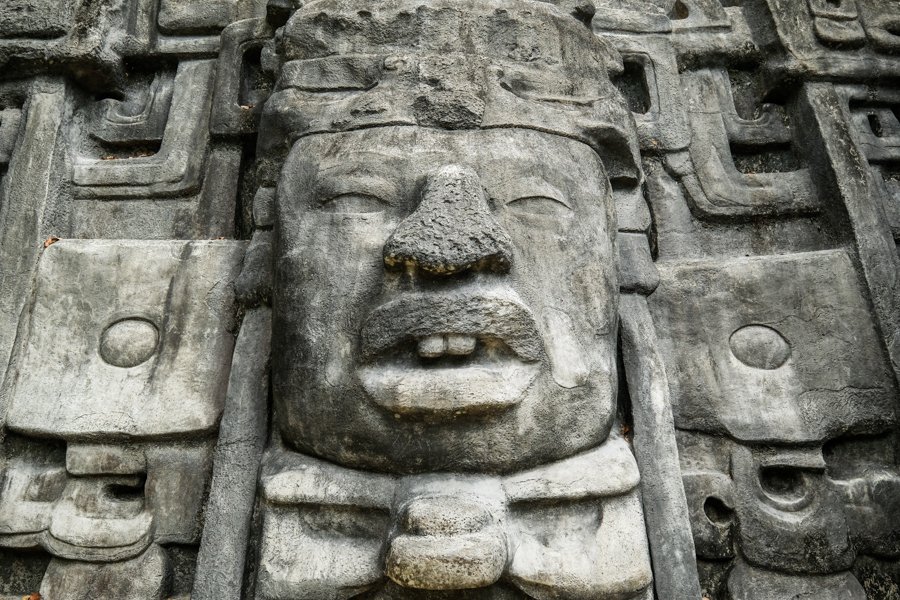

History of Lamanai: One of the Longest-Lived Mayan Cities
Archaeologists believe that the Lamanai area has been inhabited since as early as 1600 BC, making it one of the oldest continuously occupied sites in the Maya world. Remarkably, it remained inhabited until the 1600s AD, giving it one of the longest histories of any Mayan site in Central America.
Lamanai reached its peak during the Pre-Classic period of Maya civilization, roughly between the 4th century BC and the 1st century AD. This was when many of its impressive temples were built. At its height, the city may have been home to as many as 60,000 people—a bustling metropolis by ancient standards.
In the late 16th century, the Spanish attempted to convert the Maya to Christianity, even building two Catholic churches near Lamanai. However, the Maya fiercely resisted, revolting and burning down the churches. Following this, the city was gradually abandoned and swallowed by the surrounding jungle.
Lamanai remained hidden and largely forgotten for hundreds of years, until excavations began in the mid-1970s. Excavation and restoration work continues today, promising exciting new discoveries for years to come.
When I visited Lamanai, our guide mentioned that UNESCO had recently inspected the site, suggesting it might become a World Heritage Site in the near future — a well-deserved recognition for this incredible historical treasure.

Is Lamanai Worth Visiting?
Absolutely! Whether you’re a cruise passenger stopping by Belize or traveling through the region, Lamanai is definitely worth a visit.
These ruins stand out as some of the most unique and fascinating Mayan sites in Central America. From the rich history and impressive architecture to the incredible wildlife that surrounds the site, there’s so much to experience here.
Lamanai is exceptionally well preserved and has an almost cinematic quality — it really feels like stepping onto the set of an adventure movie. For all these reasons, I consider it a must-see bucket list destination.
